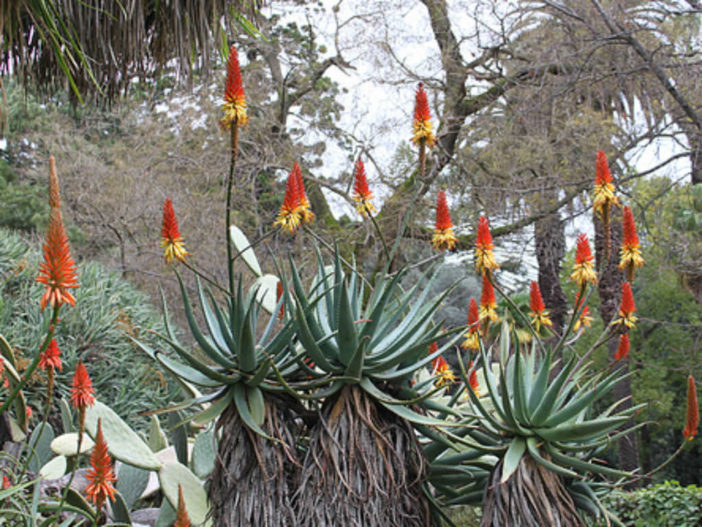Scientific Name
Aloe africana Mill.
Common Name(s)
African Aloe, Spiny Aloe, Uitenhage Aloe
Synonym(s)
Aloe perfoliata var. africana, Pachidendron africanum
Scientific Classification
Family: Asphodelaceae
Subfamily: Asphodeloideae
Genus: Aloe
Description
Aloe africana is a tree-like succulent with a usually simple stem topped with a dense rosette of dull green to somewhat glaucous leaves and covered with persistent old dried leaf remains. The stem grows up to 13.1 feet (4 m) tall, sometimes branched near the base or higher. Leaves are thick, fleshy, spreading to recurved, shallowly channeled, up to 26 inches (65 cm) long and 4.8 inches (12 cm) wide. The upper surface of the leaves is with or without a few scattered spines. The lower surface has spines in the apical median line, sometimes also scattered.
The flowers are dull red in bud, yellow-orange at maturity, cylindric, up to 2.2 inches (5.5 cm) long, all spreading downwards with the upper half markedly upcurved. They appear in up to 32 inches (80 cm) tall inflorescences, each with 2 to 4 racemes, from winter to early spring. The racemes are cylindric-acuminate, up to 24 inches (60 cm) long, and up to 4.8 inches (12 cm) in diameter.
Origin
Aloe africana is native to South Africa (Eastern Cape). It grows on sandy soil in coastal and valley bushveld in Western Cape and Eastern Cape provinces.

Hardiness
USDA hardiness zones 9b to 11b: from 25 °F (−3.9 °C) to 50 °F (+10 °C).
How to Grow and Care
Aloe is a very forgiving plant, and a well-grown plant can be quite beautiful. However, as with all succulents, Aloe must never be allowed to sit in stagnant water, and the plant should be carefully monitored to watch for signs of overwatering.
These succulents are not particularly fast-growing and will only rarely need repotting. However, in the spring, repot Aloes that tip over their pots or have ceased growing. Use a fast-draining potting mix with one-third of sand or pebbles. When repotting a larger plant, it is possible to divide the root ball carefully. Some varieties of Aloe will send off offsets that can be potted independently.
Aloe plants need strong, bright light. They can withstand full summer sun once acclimated. In the winter, provide bright light. It prefers warmer temperatures of 70 to 80 °F (21 to 27 °C) but will survive down to 40 °F (4.5 °C). Feed with a succulent fertilizer in the summer only. Suspend feeding in the winter as the plant goes dormant.
Learn more at How to Grow and Care for Aloe.
Links
- Back to genus Aloe
- Succupedia: Browse succulents by Scientific Name, Common Name, Genus, Family, USDA Hardiness Zone, Origin, or cacti by Genus
Photo Gallery
Click on a photo to see a larger version.


